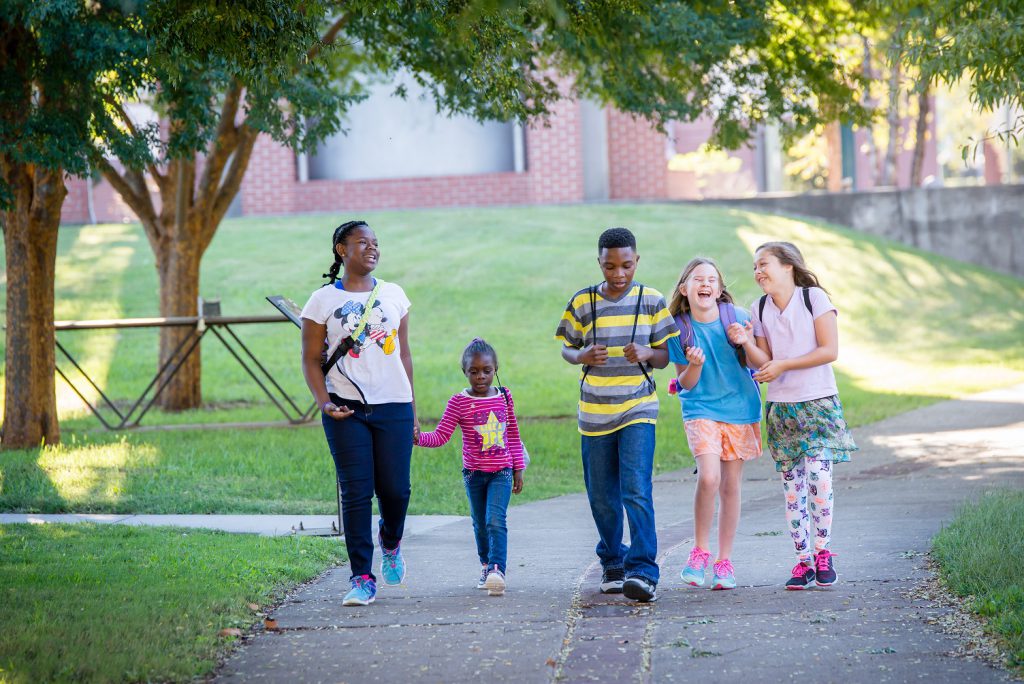By Margaux Mennesson, Marketing and Communications Manager, Safe Routes to School National Partnership
Twenty years ago, the Partnership for a Walkable America organized the very first Walk to School Day as a one-day event to promote the need for walkable communities. Today, the event is celebrated in more than 40 countries worldwide, with schools in all 50 states organizing their own unique events.

Since the first U.S. event in 1997, Walk to School Day has become the cornerstone annual event for champions of Safe Routes to School, walking, and bicycling. Each year, Walk to School Day celebrations break records for participation. And in many communities, Walk to School Day events are just one part of a school’s efforts to embrace active lifestyles. More than half of all Walk to School Day events are part of ongoing efforts to promote walking and bicycling throughout the year.
Many schools have found that hosting a Walk to School Day event helps showcase demand for walking and bicycling to officials and the wider community, leading to tangible improvements such as better crosswalks, new sidewalks, and bicycle paths. In fact, 70 percent of events in 2014 led to policy and engineering changes. For schools with programs that are up and running, Walk to School Day is celebrated as a way to bring parents, students, and school staff together, building a sense of community and fostering school spirit.
Why all the attention on walking to school?
It’s fun! Remember walking and biking around your neighborhood as a child? That sense of adventure and independence is still an important part of being a kid. When you’re walking or biking to school, you get to know your community in a different way than you do while driving – meeting neighbors and pets, observing streets on the ground level, and connecting with the sights and sounds of your neighborhood.
It’s good for kids’ health. The U.S. Department of Health and Human Services recommends 60 minutes of physical activity each day for optimal physical and mental health benefits for children. Short-term and long-term health benefits include better bone strength, academic performance, brain health, ability to focus, and healthy aging.
It’s good for the community. Many communities use the “8 to 88” test: if streets are safe for people age 8 to 88, they are safe for anyone to walk on. And more people walking means less congestion and traffic, lower health care costs, and more support for active transportation and better access to parks and recreational facilities.
However, despite the public’s increasing awareness of the individual and community benefits of walking, people are still hesitant to change behavior. That’s why encouragement events like Walk to School Day are so important and effective at instilling a love and appreciation for walking in today’s youth that will be shared among future generations.
Want to get your school in on the action for the 20th Walk to School Day? Here are a few ideas to get you going.
- Visit fireupyourfeet.org to learn more about the national Walk to School Day cash award! Any K-8 school in the country can enter the drawing for a $500 award by tracking their Walk to School Day activity using the Fire Up Your Feet online tracker. Learn more here.
- Register your event at walkbiketoschool.org to ensure your activities are counted as part of the nationwide movement for walking and bicycling.
- Invite your mayor and other elected leaders to join a walk to school on October 5, 2016 and show their support for safe streets and healthy, active kids!
Helpful Resources to Encourage Walking in Daily Life
The Safe Routes to School National Partnership offers a variety of fact sheets, reports, tools, and resources to help encourage walking and biking in daily life. Recently, new resources have been released that support walking to healthy food, walking in the workplace, and changing policy in your state to improve support for biking and walking.
Safe Routes to Healthy Food
- Safe Routes to Healthy Food: This fact sheet explores the benefits of making healthy food accessible by foot, bike, or transit, and highlights examples of how businesses, agencies, and nonprofits are taking action to improve transportation options to healthy food.
Walking During the Workday
- Ideas for Incorporating Walking Into the Workday: This fact sheet includes tips for employers and employees who want to make walking part of the workday.
- Walking Meetings: What Are They and How Do We Use Them?: How walking meetings can stimulate creativity and boost workplace morale.
- Guide to Creating a Walking Route Map: This guide provides step-by-step instructions for creating walking route maps using free tools.
- Walkability Assessment Checklist: Anyone can use this tool to assess the walkability of a route or neighborhood.
State-Level Walking and Biking Policies
- How to Use Your State’s Report Card on Walking, Biking, and Physical Activity: Learn how you can use the report cards to communicate the importance of supportive state policies and highlight ideas for inspiring change in your state.
- Understanding State Report Card Scores and Grading: This fact sheet provides a quick summary of the report cards’ scoring structure.
Spread the word! Share this post with your networks using these sample tweets:
- NEW @SRTSNow resources on walking to healthy food, state walking policies & more on the BAYW blog! http://bit.ly/2dftUvV #SafeRoutes4All
- BAYW blog highlights 20th Walk to School Day. @SRTSNow shares why & how to increase walking. http://bit.ly/2dftUvV #SafeRoutes4All